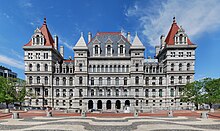New York State Legislature
New York State Legislature | |
|---|---|
 | |
| Type | |
| Type | |
| Houses | Senate Assembly |
| Leadership | |
| Structure | |
| Seats | 213 |
 | |
Political groups | Governing parties
Opposition parties
|
 | |
Political groups | Governing parties
Opposition parties
|
| Salary | $79,000 |
| Elections | |
Last election | November 4, 2014 |
Next election | November 8, 2016 |
| Meeting place | |
 | |
| New York State Capitol, Albany | |
| Website | |
| public www | |
The New York State Legislature is the two houses that act as the state legislature of the U.S. state of New York. The New York Constitution does not designate an official term for the two houses together. It says only that "legislative power is vested in the senate and assembly." The session laws are published in the official Laws of New York.[1][2] The permanent laws of a general nature are codified in the Consolidated Laws of New York.[1][3] The legislature is seated at the New York State Capitol in Albany.
Legislative Houses
Legislative elections are held in November of every even-numbered year. Both Assembly members and Senators serve two-year terms.
In order to be a member of either house, one must be a citizen of the United States, a resident of the state of New York for at least five years, and a resident of the district for at least one year prior to election.
The Assembly consists of 150 members; they are each chosen from a single-member district. The Senate, in accordance with the New York Constitution, varies in its number of members, but currently has 63.[4] Senate districts are currently between two and three times more populous than Assembly districts. As of 2009 the New York State Legislature has 2700 employees, more than any other state legislature except for the Pennsylvania General Assembly.[5]
Leaders
The Assembly is headed by the Speaker, while the Senate is headed by the President, a post held ex officio by the State Lieutenant Governor. The Lieutenant Governor, as President of the Senate, has only a tie-breaking "casting vote". More often, the Senate is presided over by the Temporary President or by a senator of the Majority Leader's choosing.
The Assembly Speaker and Senate Majority Leader control the assignment of committees and leadership positions, along with control of the agenda in their chambers. The two are considered powerful statewide leaders and along with the Governor of New York control most of the agenda of state business in New York.
Other officers
The Legislative Bill Drafting Commission (LBDC) aids in drafting legislation; advises as to the constitutionality, consistency or effect of proposed legislation; conducts research; and publishes and maintains the documents of the Legislature, such as the Laws of New York.[6][7] The LBDC consists of two commissioners, the Commissioner for Administration and the Commissioner for Operations, each appointed jointly by the Temporary President of the Senate and the Speaker of the Assembly.[8]
Party control
The New York State Legislature currently have split party control with a Democratic majority in the Assembly and a small Republican majority in the Senate. Following the 2010 elections, Republicans gained two seats in the Senate to regain control after two years in the minority. Republicans also gained nine seats in the Assembly, fracturing the veto-proof supermajority. To begin the 2009 session (elected November 2008), Democrats had a 32-30 seat majority in the State Senate and, in the Assembly, Democrats have a 109-41 seat supermajority. However, the Republicans were able to regain control of the Senate during a leadership coup, in which two Democratic Senators voted with the GOP to install a Republican majority leader. The Democratic Senators regained control of Senate leadership on July 8, 2009.

Until 2009, the State Senate had been in Republican hands for decades. Among the top reasons for this include the more conservative upstate region holding more clout in the State Senate, as well as Long Island, where voters are increasingly trending toward the Democrats on the state and local levels, yet continue to re-elect their incumbent state senators (some of whom have served for many years, such as 30+ year veterans, and most of whom have raised large amounts of money to deter challengers).
During the 21st century Republicans in the State Senate have lost ground, particularly in Westchester County and New York City, though they still hold a few senate seats representing parts of Queens, Brooklyn, and Staten Island (which leans Republican at most levels of government). Economic troubles and population loss in upstate New York are also a factor, as Democratic-leaning areas of that region have become more important in recent elections. In the past, Democrats would occasionally switch parties when they ran for the Senate so they could sit with the majority.
The Assembly has been dominated by Democrats for about 30 years. Between 2002 and 2005, the Republican conference dropped from 53 seats to 45. Republicans even lost some districts that historically have been reliably Republican, especially on Long Island. The Republican conference was increased by nine seats beginning with the 2011 session.
Constitutional powers
The Legislature is empowered to make law, subject to the governor's power to veto a bill. However, the veto may be overridden by the Legislature if there is a two-thirds majority in favor of overriding in each House. Furthermore, it has the power to propose New York Constitution amendments by a majority vote, and then another majority vote following an election. If so proposed, the amendment becomes valid if agreed to by the voters at a referendum.
History
The Legislature originated in the revolutionary New York Provincial Congress, assembled by Rebels when the Provincial Legislature would not send delegates to the Continental Congress.
The legislature's history of corruption includes the so-called Black Horse Cavalry.
In the 1840s, New York launched the first great wave of civil procedure reform in the United States by enacting the Field Code. The Code inspired similar reforms in 23 other states, and gave birth to the term "code pleading" for the system of civil procedure it created. However, many later attempts at further civil procedure reform and modernization were unsuccessful. Today, New York is widely considered to have one of the most archaic and inefficient systems of civil procedure in the United States. [citation needed]
The first African-American elected to the legislature was Edward A. Johnson, a Republican, in 1917.[9] The first women elected to the legislature were Republican Ida Sammis and Democrat Mary Lilly, both in 1919.[10] The first African-American woman elected to legislature was Bessie A. Buchanan in 1955.[11]
Five assemblymen were expelled in 1920 for belonging to the Socialist Party.[12]
In a 2008 U.S. Supreme Court decision involving the constitutionality of a law enacted by the New York Legislature, Justice John Paul Stevens wrote in his concurring opinion: "[A]s I recall my esteemed former colleague, Thurgood Marshall, remarking on numerous occasions: 'The Constitution does not prohibit legislatures from enacting stupid laws.'"[13]
Legislative leadership
New York State Senate
- Temporary President of the Senate: John J. Flanagan
- Majority Leader: John J. Flanagan
- Minority Leader: Andrea Stewart-Cousins
New York State Assembly
- Speaker of the Assembly: Carl Heastie
- Majority Leader of the Assembly: Joseph Morelle
- Minority Leader of the Assembly: Brian Kolb
See also
- New York State Legislature Elections, 2008
- New York state elections, 2010
- List of New York Legislature members expelled or censured
References
- ^ a b Gibson, Ellen M.; Manz, William H. (2004). Gibson's New York Legal Research Guide (PDF) (3rd ed.). Wm. S. Hein Publishing. p. 30. ISBN 1-57588-728-2. LCCN 2004042477. OCLC 54455036.
{{cite book}}: Invalid|ref=harv(help) - ^ Gibson & Manz 2004, pp. 47–48.
- ^ Gibson & Manz 2004, pp. 56–57.
- ^ McKinley, Jesse (24 February 2014). "What Is a Majority Vote in the State Senate? The Answer Goes Beyond Simple Math". The New York Times.
- ^ Gershman, Jacob (25 November 2009). "NY's bloated Legislature". New York Post.
- ^ Legislative Law § 25
- ^ Kallos, Ben (9 June 2014). "Set the Law Free, Say Council Members Lander, Vacca, Kallos: Legislation to Put Law Online for Free Instead of Behind Paid Subscriptions" (Press release). Retrieved 12 June 2014.
- ^ Legislative Law § 24
- ^ Dictionary of NC Biography
- ^ Early Women Elected to the NYS Legislature
- ^ Jessie Carney Smith, ed. (1996). Notable Black American Women. Vol. 2. Detroit Michigan: Gale Research Inc. pp. 73–75. ISBN 0-8103-9177-5. Retrieved 8 March 2010.
- ^ Confessore, Nicholas (2009-10-21). "When the Assembly Expelled Socialists for Disloyalty". New York Times (blog).
- ^ New York State Bd. of Elections v. Lopez Torres, 552 U.S. 196, 209 (2008) (Stevens, J., concurring).
Further reading
- "Compiling the Legislative History of a New York State Law". New York State Library. Retrieved 20 June 2014.
External links
- Official site of the New York Senate
- Official site of the New York Assembly
- Legislative information from the Legislative Bill Drafting Commission
- Legislative Retrieval System (subscription required) from the Legislative Bill Drafting Commission
- The New York State Legislature Portrait Prints Collection at the New York Historical Society


